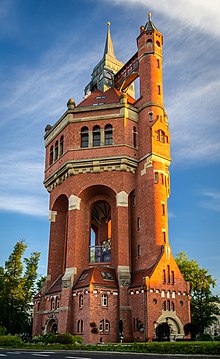Wroclaw water tower
The Wroclaw Water Tower (Wieża Ciśnień) is a former water and observation tower in the Borek district of the Krzyki District in Wroclaw ; the tower stands on a green strip of Wiśniowa avenue, but has the official address at ul. Sudecka 125a. It has not been used as a water tower since the 1980s.
It has a height of 63 meters, at a height of 42 meters there is a viewing platform from which one can see the city and its surroundings. On a clear day you can see the Zobten , Polish Ślęża about 30 km southwest of the city, and at best visibility in the same direction and the Giant Mountains , Karkonosze , with the Schneekoppe , Śnieżka , in nearly 100 km away.
history
The water tower was designed by the architect 1904-1905 Karl Klimm built that as construction officer, Mr Wroclaw city (with the rank of magistrate Commissioner of City Planning was) author of several municipal buildings, so u. a. the building trade and higher mechanical engineering school - today's Faculty of Architecture of the Technical University of Wroclaw - and the pass bridge (Zwierzyniecki bridge). Located at the intersection of Kirschenallee and Hohenzollernstrasse (ul. Sudecka), the tower served as a water supply for the southern districts of Wroclaw.
The solid building made of brickwork was designed in the style of medieval castles. In the two-story base of the building there were service apartments. The pillars rising from the base are decorated with bas-reliefs made of sandstone by the sculptors Ignatius Taschner and Robert Bednorz , just above the eaves , which show mythical creatures. The inserted into the outer wall of the base wall fountain , the fountain sculpture a the newt besteigende nymph represents the water a source that was situated in the underground spat. The fountain bore the inscription: “Don't look for beer and wine as a friend, they create short pleasure; if you want to be happy as an old man, take me to your chest. "
The architecture of the tower shows an eclectic mix of neo-Romanesque and neo-Gothic styles , while the sculptural decoration of the building reveals influences of Art Nouveau .
From the beginning, the building was equipped with an electric elevator, which from June 1906 could be used to travel to the viewing platform for a price of 10 pfennigs, from which there was a view of the city and the surrounding area. Two years later they started to inform the residents with a red flag waving on the tip if a particularly good view over the Sudeten was to be expected the next day due to the weather conditions .
Despite the heavy fighting that took place near the water tower during World War II , the tower structure remained undamaged. In 1945, at the time of the siege of the Wroclaw Fortress , the tower served as a fire control center and for battle observation. From the end of the Second World War until the 1990s, the viewing platform was not open to the public, while the water tank was used for the water supply until the mid-1980s.
Finally, in 1995 the entrepreneur Helmut Stephan bought the tower and had it restored . It housed the now closed “Wieża Ciśnień” restaurant, a conference center and the viewing platform that has been made accessible again. The tower is currently not open to the public. During the restoration, the wall fountain was moved to the wall below the elevator tower.
literature
- Gerhard Scheuermann: The Breslau Lexicon. Laumann-Verlag, Dülmen 1994, ISBN 3-87466-157-1 , p. 2894.
Web links
Coordinates: 51 ° 5 ′ 6.8 ″ N , 17 ° 1 ′ 3.2 ″ E

